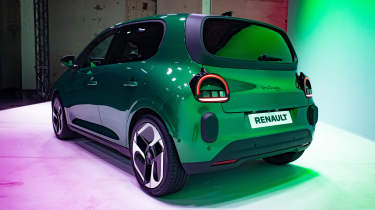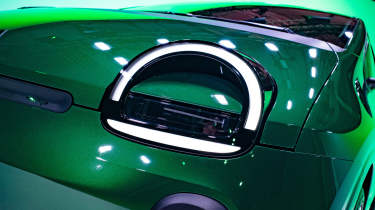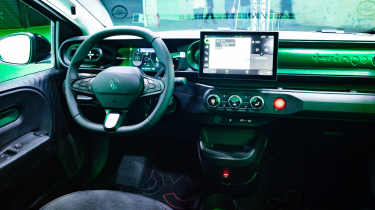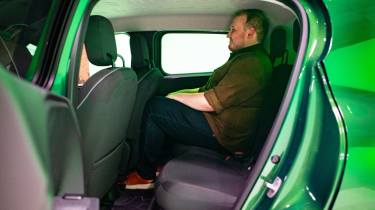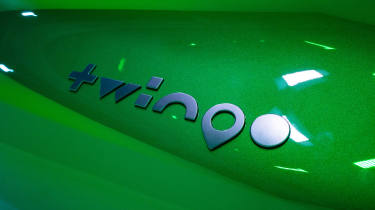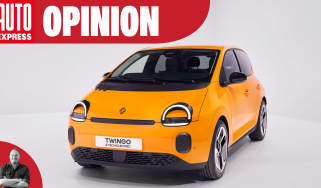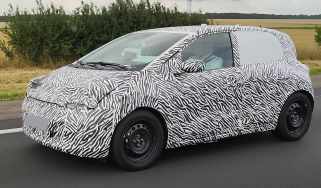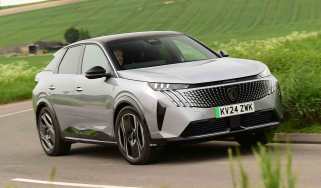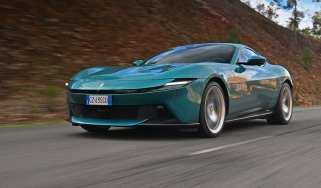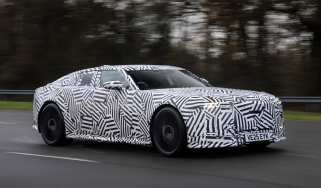New Renault Twingo preview: super cute EV city car due in 2027 with £17k price possible
Renault’s latest retro-inspired EV will go on sale in the UK late next year, before first examples arrive in 2027
The Renault Twingo has been reborn as an utterly adorable electric city car, with a flexible and playful interior, 163-mile range and, potentially, a starting price close to £17,000 when it goes on sale late next year. Could this be the game-changing small electric car we’ve been waiting for?
It certainly represents a new era of innovation for the French firm, as the new Twingo was developed in half the time it would normally take Renault to whip up a brand new car. Better still, it looks almost identical to the equally cute concept that was revealed two years ago.
The design of the new Twingo was inspired by the iconic frog-eyed original model from the nineties. The goal was to revive the spirit of that car and make sure the new model is recognisable as a Twingo, without being a mere “copy and paste”, Renault Group's head of design Laurens van den Acker told Auto Express.
The new Twingo won’t be available to order in the UK for about another year, but right now you can buy a ‘Twingo R Pass’ for £100 that ensures you’ll be among the first people to place an order and have your car delivered. If you can't wait that long for a new car, or simply want one with a longer range, why not check out the equally cute Renault 5 which can be yours for just over £21,000 through our Buy a Car service.
| Key specs | |
| Fuel type | Electric |
| Body style | City car |
| Powertrain | 1x electric motor, 27.5kWh battery, front-wheel drive |
| Price | £17,000-£20,000 (est) |
What powertrain options and performance can we expect?
The new Twingo is based on the same AmpR Small platform as the highly acclaimed Renault 5 and Renault 4, but it uses a bespoke powertrain that prioritises efficiency and cost-effectiveness.
For instance, instead of using a more energy-dense nickel manganese cobalt (NMC) battery like the R5, the Twingo features Renault’s first lithium iron phosphate (LFP) battery. It’s the same technology found in the Citroen e-C3 and other affordable EVs, and offers an ideal price-to-range ratio for a city car, according to Renault.
The compact, lightweight e-motor driving the front wheels produces just 80bhp, which isn’t that much more than the Mk1 Twingo and means 0-62mph takes 12.1 seconds. However the e-motor also delivers 175Nm of torque as soon as you put your foot down, and the Twingo only needs 3.8 seconds to get from 0-31mph – which is arguably a more relevant stat for a city car like this.
Despite the Twingo replacing the R5’s multi-link rear suspension with a simpler torsion beam set-up from the Renault Captur, we’ve been promised the new car will be almost as fun to drive as the Renault 5. That’s a rather bold claim, but the Twingo will certainly be more agile, thanks to having a turning circle of 9.87 metres, compared with 10.3 metres in its bigger brother.
| Model | Power | 0-62mph | Top speed |
| Renault Twingo E-Tech | 80bhp | 12.1 seconds | 81mph |
What do we know about the efficiency and running costs?
The 27.5kWh battery will offer up to 163 miles of range, which might not sound like a lot but most people only commute about 20 miles each day. So the Twingo should be able to handle a week’s commuting before it starts running low on juice.
Higher-spec models will also have paddles behind the steering wheel to adjust the strength of the regenerative braking and offer a one-pedal driving mode that will make stop-start city traffic easier to negotiate, plus feed more energy back into the battery.
You will have to pay extra to unlock the Twingo’s maximum DC charging speed of 50kW, which allows for a 10 to 80 per cent top-up from most rapid chargers in about half an hour. Fully recharging the battery from a standard 7kW home wallbox should take less than five hours.
| Model | Battery size | Range | Efficiency |
| Renault Twingo E-Tech | 27.5kWh | 163 miles | 5.9mi/kWh (est) |
What is the exterior and interior design like?
Design boss Laurens van den Acker told Auto Express, when designing the new Twingo, “what we needed to capture is what people have in their mind when they think about a Twingo.”
This is a “car that puts a smile on people's faces,” he said, adding, “The test was when people came in to see the new Twingo. When they left happier than when they came in, we did a good job.”
The new car’s distinguishing feature are the big, horseshoe-shaped LED front lights. These form the eyes of the Twingo’s face, while the slim plastic grille between them gives the car a cheeky little smile.
The Renault’s rounded shape is one of many styling elements borrowed from the original, as are the stubby front end and incredibly short overhangs that result from the wheels being pushed right out to the corners of the car. However, the three slats on the bonnet aren’t air intakes this time; instead, this is where you fill the windscreen washer fluid, using a special tool to open the panel.
Fans of the original Twingo will remember that it was only a three-door, whereas this new model is a five-door for added versatility. Renault also went to the effort of hiding the seals around the windows to make the Twingo look a touch more premium.
At the same time, it added chunky plastic overriders into the bumpers for added protection against the kind of light bumps and scrapes you might get on busy city streets or in a supermarket car park.
Finally, the rear features a similarly distinctive set of LED lights plus a large, almost vertical screen with a thick plastic surround that van den Acker says reminds him of the cinderblock-like TV sets from the nineties. He also told us the new Twingo’s badge was inspired by buttons on a Playstation controller.
Customers will have a choice of some suitably fun paint colours, including three new shades: Mango Yellow, Absolute Green and Absolute Red. Standard fit on all models in the UK will be 16-inch wheels with aero covers, but snazzier 18-inch rims will be available.
The interior of the new Twingo is supposed to be just as fun and charming as the exterior. It features quite possibly the best and funkiest carpets in any modern car, with more symbols inspired by video game controllers, plus a big, bright red button for the hazard warning lights on the dashboard – another nod to the nineties original.
Like every cheap-as-chips city car, the Twingo’s interior features a lot of hard black plastics. However, after sitting in the car ourselves, we think Renault has done a great job of dressing things up by adding various textures to the surfaces, as well as injecting some character with body-colour panels on the dashboard and doors. The Twingo logo embossed into the dashboard is a nice touch, too.
What do we know about the infotainment system?
Inside, every Twingo will also feature a seven-inch digital instrument panel with fun yet easy-to-read graphics, plus a 10-inch central touchscreen running Renault’s intuitive and excellent OpenR Link infotainment system. Wireless Apple CarPlay and Android Auto will be standard too, as you’d expect.
Higher-spec models will come with Google Maps, Google Assistant and other apps built-in, with access to over 100 more through the Google Play store. These cars will also get Renault’s virtual assistant, Reno – the firm’s equivalent to the old Microsoft Paperclip – which can find nearby charging points or answer general questions with help from ChatGPT.
How practical is the new Renault Twingo E-Tech and how big is the boot space?
The Twingo was designed to offer supermini levels of space in a city car. Much to our surprise, despite the car being just 3.79 metres long – shorter than a three-door MINI Cooper – we proved six-foot-tall adults can sit in the back of the Renault. Only just mind you, because anyone of that height will find their heads brushing against the roof.
Passenger’s knees may also be pressed against the back of the front seats, but this area is soft and squidgy at least, so owners should be able to give friends a lift into town. But it’s much better suited to small children, and there are two sets of Isofix mounting points in the back, too, hidden behind zips.
As in the original Twingo, there are individual sliding rear seats that can be pushed forward by up to 17cm, which is easily done using tabs either in the boot or the rear cabin. This eats up the rear-cabin space, but expands the boot capacity from 250 litres – which is already on par with petrol-powered city cars – to a whopping 360 litres. That’s nearly as much as a VW Golf can provide.
50 litres of that is underfloor storage, ideal for keeping the charging cables out of sight. But more impressive is the two-piece floor Renault designed to allow easy access to that space and the charging cables when there’s other stuff in the boot.
But when you need all the space you can get, the rear seats can also fold down completely flat and will give you more than 1,000 litres to play with. There’s no parcel shelf to get in the way, because the rear windscreen is made from privacy glass.
There’s a further 19 litres of storage around the cabin, according to Renault, which has also pinched Dacia’s clever YouClip system. The three anchor points inside are for attaching various accessories including an LED light, 3D-printed USB cable reel or handy foldable shopping bag.
| Dimensions | |
| Length | 3,789mm |
| Width | 1,720mm |
| Height | 1,491mm |
| Number of seats | 4 |
| Boot space | Up to 360 litres |
What safety tech does the new Renault Twingo E-Tech have?
The Twingo will be available with up to 24 driver-assistance systems, such as adaptive cruise control and occupant safe exit alert, but Renault has also fitted its ‘My Safety Perso’ button, which allows drivers to deactivate a number of these features with just two taps.
How much will the new Renault Twingo E-Tech cost?
As we said, the new Renault Twingo won’t go on sale in the UK until late next year, and first examples aren’t due to arrive on our roads until 2027.
So far, all Renault has said is the new Twingo will cost less than 20,000 Euros in Europe, and less than £20,000 in the UK, without incentives. If we assume a starting price of around £18,000 to £19,000, that would already make this one of the most affordable electric cars on the market.
If the Government’s Electric Car Grant (ECG) is still available at the time – which it should be – the Twingo should be eligible for at least a £1,500 discount. In part because it���s going to be built in Europe – Slovenia, to be precise.
The ECG would allow the Twingo to drop to nearer £17,000, which would make it among the cheapest new cars on sale, along with petrol-powered city cars and superminis such as the Kia Picanto and MG3.
Other small EVs such as the dinky Dacia Spring and Leapmotor T03 are available from around £15,000 and £16,000, respectively. The award-winning Citroen e-C3 now starts from under £21,000 (thanks to the ECG), as does the Fiat Grande Panda Electric. In case you’re wondering, the Renault 5 costs from £21,495, after the ECG has been applied.
Ordering a Twingo should be easy, because there’ll only be one powertrain, plus a choice of either Evolution or Techno specification. We’re not expecting a big price jump between the two, given that Renault has promised higher-spec models will be offered at an “attractive price”.
Standard kit will include those dual displays, plus wireless smartphone connectivity, sliding rear seats, rear parking sensors, cruise control, lane-keep assist and a driver-monitoring system. Techno trim adds, among other things, those Google services, one-pedal driving, a reversing camera, keyless entry and automatic high beams.
Get the latest and best car news and reviews, first! Follow Auto Express on Google today
Find a car with the experts


